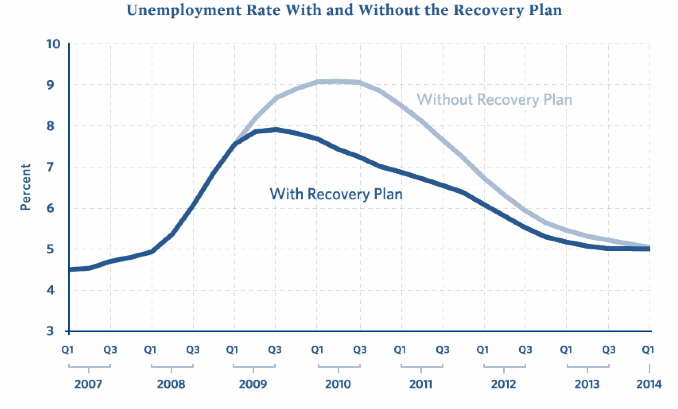
9. Both the Barack Obama and the George W Bush Administrations tried to use fiscal policy to stimulate the economy. The Bush Administration proposed the Economic Stimulus Act of 2008 to head off recession. It offered tax rebates and was passed in February of 2008. The Obama Administration differed from the Bush Administration primarily in stressing the spending side of fiscal policy rather than the taxing side. Its response to the sharp downturn in economic activity following the collapse of Lehman Brothers in September of 2008 was the American Recovery and Reinvestment Act of 2009. This act consisted of a mishmash of various spending projects and transfers, with a few changes in the tax code thrown in. It became law in February of 2009.
The economic advisors to the Obama Administration tried to predict what the economy would do with and without their stimulus package. Using an the assumption that the average multiplier for the various kinds of spending is 1.6, they produced the graph below.

The economy followed neither of the tracks in the graph above. The unemployment rate went higher than either path and declined much more slowly than forecast. (See, for example, here). There are at least three possible explanations for why the forecast was so wrong. It may be that fiscal policy does not work. The multiplier may be even smaller than the Obama advisors assumed. Alternatively, it may be that the economic advisors seriously underestimated how serious the recession would be, and that the stimulus package worked because it prevented a much more serious recession from occurring. Finally, some have argued that you do not see an effect because the rise in federal government spending was partially offset by (and may have contributed to) a decline in state and local government spending.
a. The argument of the text that fiscal policy has four shortcomings—lags, too many side effects, the political nature of the decision making process, and crowding out—was written before 2009. How well does it fare when applied to the American Recovery and Reinvestment Act of 2009?
b. Should we take seriously the argument that, even though the forecast was wildly wrong, the policy worked because otherwise the recession would have been far worse? Can't this kind of argument be made for any policy that goes wrong?
|
|
|